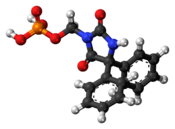Fosphenytoin
 | |
 | |
| Clinical data | |
|---|---|
| Trade names | Cerebyx, Pro-Epanutin |
| AHFS/Drugs.com | Monograph |
| MedlinePlus | a604036 |
| License data |
|
| Routes of administration | Intravenous, intramuscular |
| ATC code | |
| Legal status | |
| Legal status | |
| Pharmacokinetic data | |
| Bioavailability | 100% (IM) |
| Protein binding | 95–99% |
| Metabolism | Liver |
| Elimination half-life | 15 minutes to convert to phenytoin |
| Excretion | Kidney (as phenytoin) |
| Identifiers | |
| |
JSmol) | |
| |
| |
| | |
Fosphenytoin, also known as fosphenytoin sodium, and sold under the brand name Cerebyx among others, is a water-soluble phenytoin prodrug that is administered intravenously to deliver phenytoin, potentially more safely than intravenous phenytoin. It is used in the acute treatment of convulsive status epilepticus.
Fosphenytoin was developed in 1996.
Medical uses
Fosphenytoin is approved in the United States for the short-term (five days or fewer) treatment of epilepsy when more widely used means of phenytoin administration are not possible or are ill-advised,
Other
In 2003, it was reported that even though anticonvulsants are often very effective in mania, and acute mania requires rapid treatment, fosphenytoin had no antimanic effect.[6]
Metabolism
One
Side effects
Side effects are similar to intravenous phenytoin and include hypotension, cardiac
History
Phenytoin, in both its acidic and sodium salt forms, is erratically bioavailable whether it is injected or taken orally due to its high
Fosphenytoin was approved by the Food and Drug Administration (FDA) on August 5, 1996, for use in epilepsy.[10]
See also
References
- FDA. Retrieved 22 Oct 2023.
- ISBN 9780080457024.
- ^ "Fosphenytoin Sodium Approval History". Retrieved 20 October 2005.
- ^ a b Parke-Davis (2001). "Cerebyx: Fosphenytoin Sodium Injection - Labeling Revision" (PDF). Cerebyx Approval History. Warner-Lambert Company. Archived from the original (PDF) on October 17, 2003. Retrieved 20 October 2005.
- PMID 11447516.
- PMID 12716241.
- S2CID 6664220.
- PMID 6864479.
- ^ Tuen C. "Anticonvulsants before 1993". Neuroland. Archived from the original on 4 August 2019.
- ^ "Cerebyx Approval History". Retrieved 20 October 2005.
External links
- "Fosphenytoin". Drug Information Portal. U.S. National Library of Medicine.
- "Fosphenytoin sodium". Drug Information Portal. U.S. National Library of Medicine.
